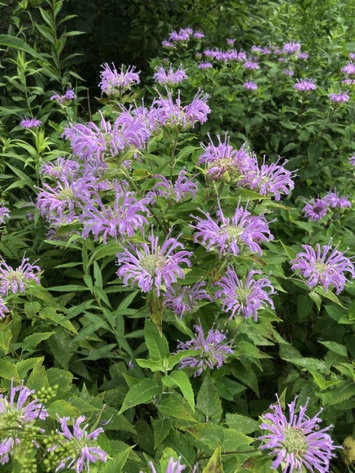About This Site -- Wildflowers of Jackon Park
This site is a serendipitous consqeuence of the Coronavirus pandemic of 2020. Confined like everyone else, I resolved to take a long daily walk for basic exercise, and by late winter I also realized that I was not going to travel anywhere for the rest of the year. Starting in early May, I began to walk in Jackson Park and took to photographing the wildflowers found there. The result is a kind of informal census of the the Park's flora. It grew into a project much larger than I originally anticipated.

Wild Bergamot, 12 July 2020. ©Fred M. Donner
Disclaimer:
All photographs, except as marked, are my own, taken using my iPhone SE. All photographs of plants were taken in Jackson Park, Chicago (boundaries: 56th Street to 67th Street, Stony Island Avenue to Lake Michigan). I am neither a trained botanist nor a professional photographer. I have tried to provide accurate identifications for the plants pictured, but cannot guarantee that I have done so correctly in every case, and the information and photographs on this site should not be used for scientific purposes without further corroboration.
All photographs, except as marked, and content of this site are ©2021 Fred M. Donner. Photos may be used for non-commercial purposes without consultation as long as you identify me as the photographer/copyright holder. For commercial uses, please contact me to arrange terms. (See contact information below.)
Resources:
Basic plant identification--knowing an aster from a milkweed, for example--is usually quite simple, but distinguishing among many similar species (some of which may exist in several poorly-described varieties, and which may also hybridize to form intermediate forms) is often maddeningly difficult. My initial identifications were usually made based on Roger Tory Peterson and Margaret McKenny's A Field Guide to Wildflowers (Northeastern/NorthCentral North America) (Houghton Mifflin, 1968), which is incomparably convenient. Also helpful for a 'quick fix' was The Audubon Society Field Guide to North American Wildflowers, Eastern Region by William A. Niering and Nancy C. Olmstead (Alfred A. Knopf, 1979). For more detailed inquiries, I sometimes consulted Gray's New Manual of Botany, 7th edition, by Asa Gray, as revised by Benjamin Lincoln Robinson and Merritt Fernald (American Book Company, 1908).
Advances in genetics have completely revolutionized the study of plant biology since the publication of the volumes listed above. Widespread testing of plant DNA has allowed taxonomists in many cases to confirm the close association of related plant species, but in many others it has led to dramatic reclassifications, splitting long-establihed genera and species into two or more distinct ones, or affiliating a particular plant with a different species or genus than the one to which it had formerly been assigned. Information is changing constantly, and the internet is probably the best--and perhaps the only--way to try to keep abreast of these changes. A simple internet search under almost any plant name will usually lead to several different sites that offer information and images that are extremely helpful. The natural resources department of nearby states (especially Wisconsin, Michigan, and Indiana) have valuable websites detailing wildflowers found in those states. Most helpful of all, however, has been the outstanding website maintained by Dr. John Hilty of Urbana Illinois, www.illinoiswildflowers.info. This site provides a meticulous description of plants identified within the state, including their range, habitat, faunal associations, and other information. It has been invaluable to me in sorting out many plants and I recommend it to everyone who has read this far!
Corrections, comments, and queries should be directed to the following address:
jpwildflowers2021@yahoo.com
Photographs and text on this site, except as otherwise noted, are ©2021 Fred M. Donner